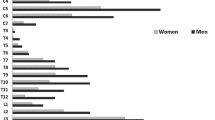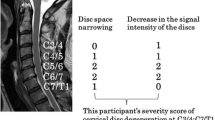Abstract
The objective of the current study was to find out whether yoga practice was beneficial to the spine by comparing degenerative disc disease in the spines of long-time yoga practitioners and non-yoga practicing controls, using an objective measurement tool, magnetic resonance imaging. This matched case–control study comprised 18 yoga instructors with teaching experience of more than 10 years and 18 non-yoga practicing asymptomatic individuals randomly selected from a health checkup database. A validated grading scale was used to grade the condition of cervical and lumbar discs seen in magnetic resonance imaging of the spine, and the resulting data analyzed statistically. The mean number of years of yoga practice for the yoga group was 12.9 ± 7.5. The overall (cervical + lumbar) disc scores of the yoga group were significantly lower (indicating less degenerative disc disease) than those of the control group (P < 0.001). The scores for the cervical vertebral discs of the yoga group were also significantly lower than those of the control group (P < 0.001), while the lower scores for the yoga group in the lumbar group approached, but did not reach, statistical significance (P = 0.055). The scores for individual discs of yoga practitioners showed significantly less degenerative disease at three disc levels, C3/C4, L2/L3 and L3/L4 (P < 0.05). Magnetic resonance imaging showed that the group of long-term practitioners of yoga studied had significantly less degenerative disc disease than a matched control group.


Similar content being viewed by others
References
Guarracino JL, Savino S, Edelstein S (2006) Yoga participation is beneficial to obesity prevention, hypertension control, and positive quality of life. Top Clin Nutr 21:108–113
John PJ, Sharma N, Sharma CM et al (2007) Effectiveness of yoga therapy in the treatment of migraine without aura: a randomized controlled trial. Headache 47:654–661
Breuner CC (2006) Alternative and complementary therapies. Adolesc Med Clin 17:521–546
Herrick CM, Ainsworth AD (2000) Invest in yourself: Yoga as a self-care strategy. Nurs Forum 35(2):32–36
Oken BS, Kishiyama S, Zajdel D et al (2004) Randomized controlled trial of yoga and exercise in multiple sclerosis. Neurology 62:2058–2064
Taylor MJ (2003) Yoga therapeutics: an ancient, dynamic systems theory. Tech Orthop 18:115–125
Chen K, Tseng WS, Ting LF et al (2007) Development and evaluation of a yoga exercise programme for older adults. J Adv Nurs 57:432–441
Katz JN, Simmons BP (2002) Carpal tunnel syndrome. N Engl J Med 346:1807–1812
Devereaux MW (2007) Anatomy and examination of the spine. Neurol Clin 25:331–351
Hogg-Johnson S, van der Velde G, Carroll LJ et al (2008) The burden and determinants of neck pain in the general population: results of the bone and joint decade 2000–2010 task force on neck pain and its associated disorders. Spine 33:S39–S51
Hazard RG (2007) Low-back and neck pain diagnosis and treatment. Am J Phys Med Rehabil 86:S59–S68
Schenk P, Laubli T, Hodler J et al (2006) Magnetic resonance imaging of the lumbar spine findings in female subjects from administrative and nursing professions. Spine 31:2701–2706
Roh JS, Teng AL, Yoo JU et al (2005) Degenerative disorders of the lumbar and cervical spine. Orthop Clin N Am 36:255–262
Levin KH (2007) Nonsurgical interventions for spine pain. Neurol Clin 25:495–505
Sherman KJ, Cherkin DC, Erro J et al (2005) Comparing yoga, exercise, and a self-care book for chronic low back pain: a randomized, controlled trial. Ann Intern Med 143:849–856
Hurwitz EL, Carragee EJ, Velde G et al (2008) Treatment of neck pain: noninvasive interventions: results of the bone and joint decade 2000–2010 task force on neck pain and its associated disorders. Spine 33:S123–S152
Dillard JN, Knapp S (2005) Complementary and alternative pain therapy in the emergency department. Emerg Med Clin N Am 23:529–549
Fujiwara A, Tamai K, Yamato M et al (1999) The relationship between facet joint osteoarthritis and disc degeneration of the lumbar spine: an MRI study. Eur Spine J 8:396–401
Pappou IP, Cammisa FP, Girardi FP (2007) Correlation of end plate shape on MRI and disc degeneration in surgically treated patients with degenerative disc disease and herniated nucleus pulposus. Spine J 7:32–38
Pfirrmann CWA, Metzdorf A, Zanetti M et al (2001) Magnetic resonance classification of lumbar intervertebral disc degeneration. Spine 26:1873–1878
Peterson CK, Gatterman B, Carter JC et al (2007) Inter-and intraexaminer reliability in identifying and classifying degenerative marrow (Modic) changes on lumbar spine magnetic resonance resonance scans. J Manipulative Physiol Ther 30:85–90
Miyanji F, Furlan JC, Aarabi B, Arnold PM, Fehlings MG (2007) Acute cervical traumatic spinal cord injury: MR imaging findings correlated with neurologic outcome—prospective study with 100 consecutive patients. Radiology 243:820–827
Modic MT, Ross JS (2007) Lumbar degenerative disk disease. Radiology 245:43–61
Shapiro GS, Taira G, Boachie-Adjei O (2003) Results of surgical treatment of adult idiopathic scoliosis with low back pain and spinal stenosis: a study of long-term clinical radiographic outcomes. Spine 28:358–363
Greendale GA, Huang MH, Karlamangla AS et al (2009) Yoga decreases kyphosis in senior women and men with adult-onset hyperkyphosis: results of a randomized controlled trial. J Am Geriatr Soc 57(9):1569–1579
Glassman SD, Bridwell K, Dimar JR et al (2005) The impact of positive sagittal balance in adult spinal deformity. Spine 30:2024–2029
Author information
Authors and Affiliations
Corresponding author
Rights and permissions
About this article
Cite this article
Jeng, CM., Cheng, TC., Kung, CH. et al. Yoga and disc degenerative disease in cervical and lumbar spine: an MR imaging-based case control study. Eur Spine J 20, 408–413 (2011). https://doi.org/10.1007/s00586-010-1547-y
Received:
Revised:
Accepted:
Published:
Issue Date:
DOI: https://doi.org/10.1007/s00586-010-1547-y




